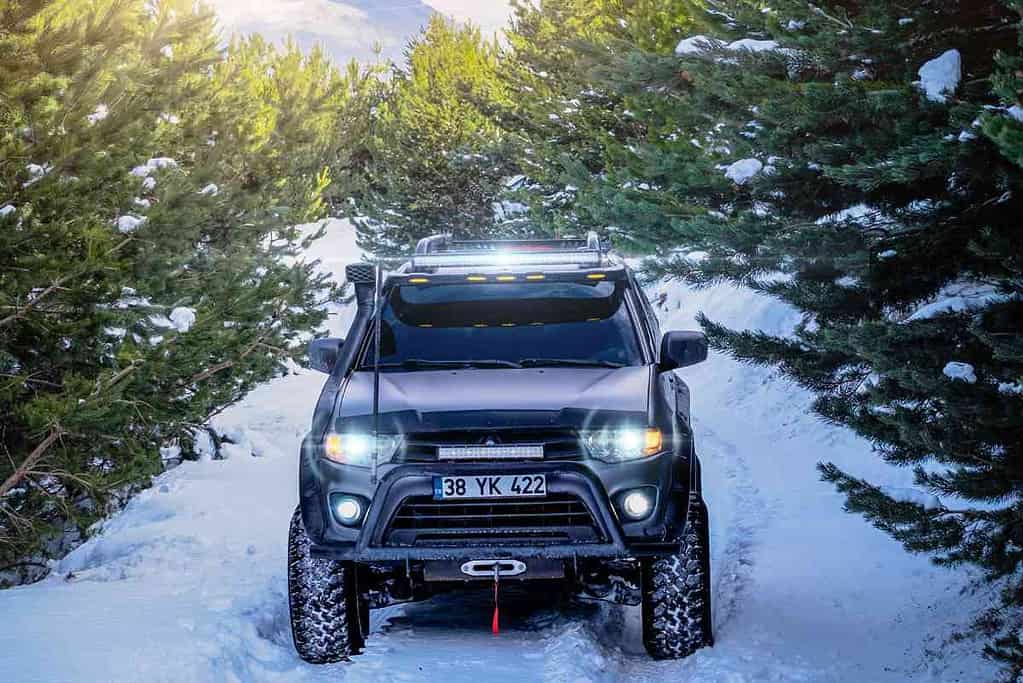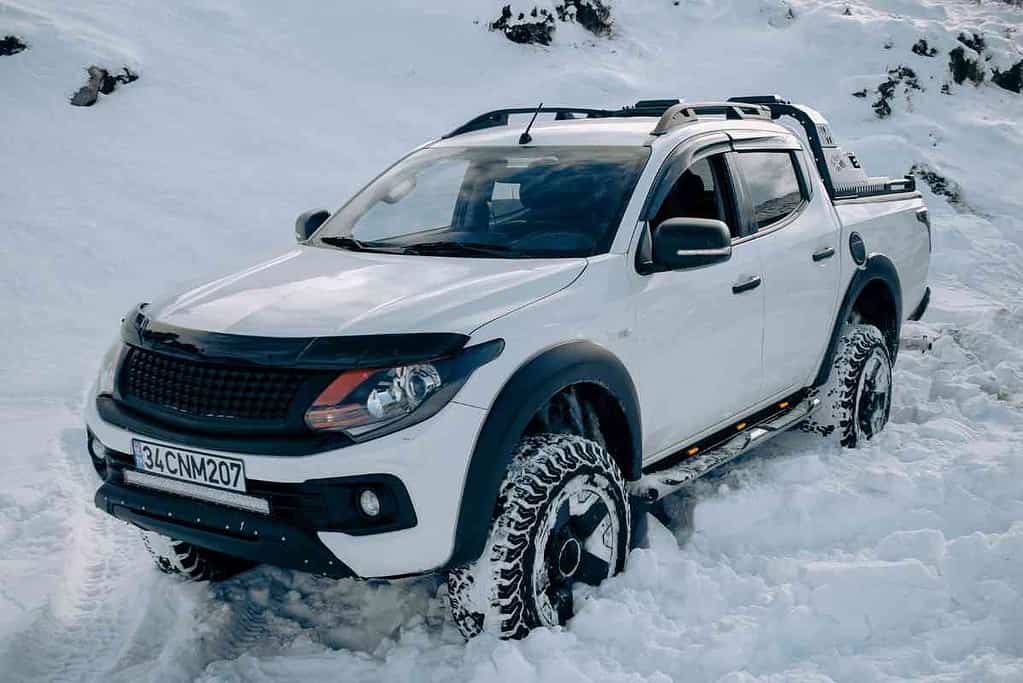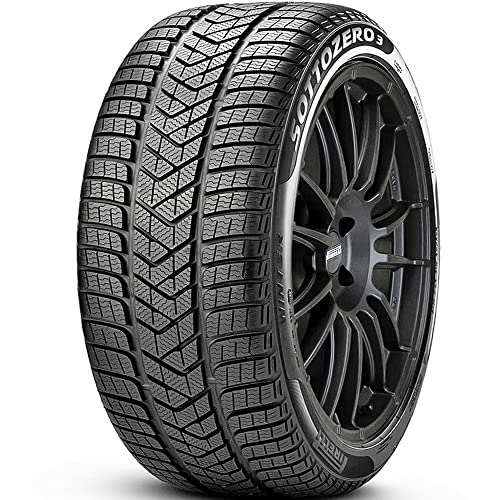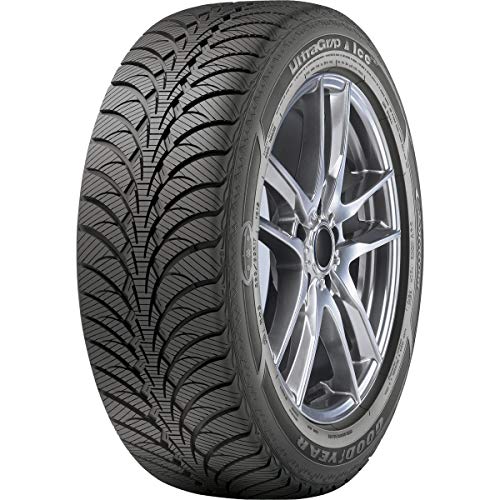Driving A 2WD Truck In Snow: 12 Tips & Tricks To Drive Safer
While your pickup truck is built to go almost anywhere, are you aware that the situation can quickly change when it comes to driving your 2WD truck in the snow?

Is It Safe To Drive A 2WD Truck In The Snow?
Although it’s possible to drive a 2WD truck in the snow, it can be a very challenging experience, especially if the roads are slick with ice. This is because 2WD trucks generally have less traction and stability, making them harder to control in slippery conditions.
Having lived and driven in snow-prone areas for many years, I can factually state that driving a 2WD truck in snowy conditions is indeed quite challenging.
I’ve also talked to seasoned winter drivers and automotive experts who have given me tips that are required to navigate such conditions.
A brief overview of 2WD trucks
Before going deeper into whether it’s okay to drive a 2WD truck in the snow, let’s briefly talk about what two-wheel drive means
A 2WD (two-wheel drive) truck generally refers to a vehicle that’s designed with a drive system, which only powers two of the vehicle’s wheels.
Unlike the 4WD truck that has a drive system powering all the wheels, a 2WD can either be a front-wheel drive vehicle or a rear-wheel drive vehicle but most 2WD trucks have rear-wheel drive.
In other words, front-wheel drive vehicles are a rarity.
2WD trucks tend to be lighter and this can affect their traction, stability, and power in rear wheels, which can make you struggle driving them on a slick road.
Is it okay to drive a rear-wheel drive truck in the snow?
It’s, unquestionably a challenging experience to drive a rear-wheel drive vehicle in the snow.
Besides risking getting stuck in deep snow, there’s an increased danger of driving a 2WD truck in the snow because ice-covered roads are more prone to skidding and sliding.
You’ll experience such issues because 2WD trucks have less traction and stability. This makes them more difficult to control on snow-covered roads. They also do not have an extra set of rear wheels that can help in pushing the vehicle through deep snow.

What should you do if you have to drive a 2WD truck in the snow?
If you’re planning to drive a rear-wheel drive truck in heavy snow, it’s vital that you prepare your vehicle for these conditions.
In this section, let’s walk you through a few things that you can do to prepare your 2WD truck for snowy conditions.
Get a 2WD with improved traction control
Thanks to modern automotive technology, you can get a rear-wheel drive truck that’s designed with ultra-modern traction control systems, especially in rear wheels.
These systems will improve the traction of your vehicle in extreme winter conditions.
Use winter tires
One of the most important things to incorporate in your rear-wheel drive truck when planning to drive in snow is the winter tires.
Unlike all-season tires, winter tires are particularly designed to provide your vehicle with improved traction, stability, and handling in cold and snowy conditions.
Of course, you can’t compare winter tires with all-season tires that are designed for various conditions.
In other words, winter tires or good snow tires are specifically made from a unique rubber compound that remains flexible even in the coldest of conditions. It’s this flexibility that allows your winter tires to effectively grip the road and provide better traction and handling on snow and ice.
Again, winter tires are designed with specialized tread patterns that will provide your vehicle with better traction in snow and slush.
These patterns are rare in all-season tires and will also help in effectively evacuating water and snow and thereby reducing the risk of hydroplaning on icy roads.
What are some of the best winter tires for your 2WD truck?
By now, you’re probably wondering about some of the best winter tires for your 2WD trucks. Well, here’s a summary of some of the best snow tires just to ensure that you have good tires for snow.
Michelin X-Ice Xi3
- This 3rd generation X-Ice winter tire provides the necessary traction to safely overcome extreme winter conditions featuring Cross Z Sipes , Micro-Pumps, and FleX-Ice compound.
- The MICHELIN X-Ice Xi3 tire provides winter performance with MICHELIN MaxTouch Construction which features a unique contact patch shape - maximizing even and longer tread life.
- The MICHELIN X-Ice Xi3 is also designed to be environmentally friendly to help reduce fuel consumption in addition to having excellent winter grip and long lasting tread life.
One of the best snow tires. Offers excellent traction and handling in snow, good fuel efficiency, and a comfortable ride
Pirelli Winter SottoZero
- Three Peak Mountain Snowflake certified for use in moderate to severe winter weather conditions
- 3D sipe technology and an optimized footprint improve grip and stability on dry roads
- Built with a directional, double arrow tread pattern and dense siping that increases traction and grip on snowy roads
- Two wide grooves within the tread force water out of the tire to reduce the risk of hydroplaning on wet roads
- Select sizes are available with Pirelli's RunFlat, Noise Cancelling System (PNCS), and SealInside technologies
These are high-performance real snow tires with excellent traction and handling. Comes with specialized tread patterns to improve grip and stability
Goodyear UltraGrip Ice WRT
- Product Type:Vehicle Tire
- Item Package Dimensions:30.0 " L X 30.0 " W X 8.0 " H
- Item Package Weight:36.0 lbs
- Speed Rating : S
This is another high-performance winter tire with exceptional traction and handling and an advanced tread pattern for improved stability
Nokian Hakkapeliitta R3
- Stone Ejectors - Keeps main grooves clean preventing "stone drilling" and as a result helps to extend the life of the tire.
- Maximum Winter Driving Comfort in any condition
- Excellent Grip And Controlled Handling On Ice And Snow
- Saves On Fuel Costs
This is a premium winter tire with excellent traction, good handling, and a comfortable ride
Bridgestone Blizzak DM-V2
- Confident Stopping Power On Snow And Ice
- Reliable Handling In Winter Conditions
- Bite Particles For Impressive Traction On Ice
- Backed by Bridgestone's Winter Tire Limited Warranty
- Next-Generation Multicell Compound Next Generation Multicell Compound With Hydrophilic Coating Removes Water From The Surface Of The Tire To Give You Better Traction On Snow And Ice.
This is a studless winter tire with excellent traction, improved handling, and fuel efficiency
Maybe just as important as the best tires for winter driving are some of the worst tire brands for winter driving. If you’re not buying one of the tires listed above, definitely check out our article so you don’t buy a dud.
Have good brakes
The importance of having good brakes on your vehicle can’t be emphasized enough. But good brakes are even more important if you’re planning to drive a rear-wheel drive car in extreme conditions.
As we’ve noted countless times already, slush and ice will reduce the traction between rear-wheel drive vehicles and the road.
This means that you’ll find it more difficult to stop the vehicle, so you need good brakes.
In essence, you need good brakes to ensure that the vehicle stops quickly in snowy conditions. You should, however, avoid sudden braking as this can make the wheels lock up, which may lead to loss of control, leaving you in a precarious position.
Have a strong and reliable battery
As far as the battery is concerned, you have to ensure that your 2WD truck has a strong and reliable battery to ensure that it runs smoothly even in cold weather.
Cold temperatures are likely to reduce the battery’s performance by thickening its fluid and this can reduce the battery’s ability to supply power to the vehicle’s electrical systems.
If you’re driving a rear-wheel drive truck in snow and you have a weak battery, your engine’s performance will reduce and the vehicle is likely to stall; something that you don’t want to encounter in snowy conditions.
Other accessories and modifications
If you’re planning to drive your 2WD truck in the snow, there are various accessories that can help improve the performance of your vehicle in extreme conditions. Let’s briefly highlight them.
- Skid plates – This is a protective accessory that you can add to the undercarriage of your 2WD truck to protect it from damage caused by logs, rocks, or other objects in the snow. They also prevent snow and ice from building up under the vehicle thereby improving traction and stability.
- Snow plows – For pushing snow from driveways or roads. You have to attach them to the front of your truck and can be operated by a remote or manually.
- Wheel wells – You can add these to the bed of your 2WD truck to offer additional clearance when driving on ice. This helps in improving traction and stability while also reducing the risk of getting stuck.
- Snow tire chains – This is a special tire accessory that helps improve traction when driving in snow. You have to attach them to your truck’s tires.
- Snow blowers – This is another option for clearing snow. You can mount them on the bed of your 2WD truck.
Add sufficient weight to the truck
You can consider adding weight to your rear-wheel drive truck. The idea here is to put extra weight on the rear axle, which generates power.
This will give your truck a better grip on the road and reduce the chances of the truck losing control. Besides using sand bags, you can add bags of dirt or containers of kitty litter.
What are the safety tips for driving a 2WD truck in the snow?

Your safety should always be paramount in whatever you do. You should, therefore, adhere to the following safety tips when snow driving.
Slow down
Besides slippery roads, your visibility will significantly reduce in ice and snow, so it’s safe to accelerate slowly and keep longer distances from other motorists.
Avoid sudden movements and stay calm
Whether it’s sudden acceleration or braking, you should avoid them as they’ll make your rear-wheel drive truck have inferior traction and you could lose control of the vehicle.
Avoid spinning the wheels
You should avoid spinning your wheels as this can cause your truck to get stuck in the snow.
Avoid using cruise control
When using cruise control, your reaction to changing road conditions may be significantly reduced.
And because you’re driving in snowy or icy conditions that reduce the traction of the vehicle, it can be quite challenging to respond quickly to slippery patches, sudden stops, and obstacles on the slick road.
Keep a winter survival kit in your truck
Your winter survival kit should include items such as a blanket, food, water, warm clothing, a cell phone charger, and a flashlight.
Prepare your truck for winter driving
In addition to installing winter tires, having good brakes, and having a reliable battery, you should make sure that you regularly maintain your vehicle.
You should also ensure that you chose the right tires for your car and they’re properly inflated for winter driving.
Generally speaking, you should consider slightly reducing your tire pressure by 2-4 psi from your normal driving pressure. This is to help increase the tire’s footprint on the snow, which can then help in improving traction.
That being said, you should also avoid going below the minimum tire pressure as stipulated by the manufacturer as these can negatively affect not just the life of the tire but also handling and stability.
Should you own a 2WD truck if you live in a snowy place?
While there are challenges associated with driving a 2WD truck in snow, the decision to own a 2WD truck if you live in a snowy place depends on your needs, driving conditions, and experience.
If you do not drive regularly and the roads are well-maintained, then a 2WD truck can be a good option. But if you drive regularly and the roads are snowy, then a four-wheel drive truck may be the better option because it provides better traction and stability.
Key takeaways
- You can drive a 2WD truck in snow but it might not be the ideal option
- To drive a 2WD truck in winter, you need to install winter tires
- Having good brakes, a reliable battery, and skid plates are also essential
- You have to make sure that your safety is paramount
- You can consider a 4WD truck instead of a 2WD truck





